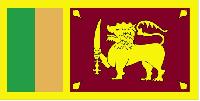 In celebration of Focus Asia Month, the Office of Student Engagement and Multicultural Affairs, along with the Asian American Alliance, is shedding this week's spotlight on Sri Lanka.
In celebration of Focus Asia Month, the Office of Student Engagement and Multicultural Affairs, along with the Asian American Alliance, is shedding this week's spotlight on Sri Lanka. In celebration of Focus Asia Month, the Office of Student Engagement and Multicultural Affairs, along with the Asian American Alliance, is shedding this week's spotlight on Sri Lanka.
In celebration of Focus Asia Month, the Office of Student Engagement and Multicultural Affairs, along with the Asian American Alliance, is shedding this week's spotlight on Sri Lanka.
The first Sinhalese arrived in Sri Lanka late in the 6th century B.C., probably from northern India. Buddhism was introduced in about the mid-third century B.C., and a great civilization developed at the cities of Anuradhapura (kingdom from circa 200 B.C. to circa A.D. 1000) and Polonnaruwa (from about 1070 to 1200). In the 14th century, a south Indian dynasty established a Tamil kingdom in northern Sri Lanka. The coastal areas of the island were controlled by the Portuguese in the 16th century and by the Dutch in the 17th century. The island was ceded to the British in 1796, became a crown colony in 1802, and was formally united under British rule by 1815. As Ceylon, it became independent in 1948; its name was changed to Sri Lanka in 1972. Tensions between the Sinhalese majority and Tamil separatists erupted into war in 1983. After two decades of fighting, the government and Liberation Tigers of Tamil Eelam (LTTE) formalized a cease-fire in February 2002 with Norway brokering peace negotiations. Violence between the LTTE and government forces intensified in 2006, but the government regained control of the Eastern Province in 2007. By May 2009, the government announced that its military had defeated the remnants of the LTTE.
The flag of Sri Lanka is yellow with two panels; the smaller hoist-side panel has two equal vertical bands of green (hoist side) and orange; the other larger panel depicts a yellow lion holding a sword on a dark red rectangular field that also displays a yellow bo leaf in each corner; the yellow field appears as a border around the entire flag and extends between the two panels; the lion represents Sinhalese ethnicity, the strength of the nation, and bravery; the sword demonstrates the sovereignty of the nation; the four bo leaves - symbolizing Buddhism and its influence on the country - stand for the four virtues of kindness, friendliness, happiness, and equanimity; orange signifies Sri Lankan Tamils, green the Sri Lankan Moors; dark red represents the European Burghers, but also refers to the rich colonial background of the country; yellow denotes other ethnic groups; also referred to as the Lion Flag
Information obtained from www.cia.gov - The World Factbook
JOIN US IN THE CELEBRATION OF FOCUS ASIA MONTH!
Tuesday, April 19 at 7:00 p.m. in Klingenstein Lounge
Future of the Asian-American Studies Program
Presentation and Discussion
Monday, April 25 at 7:00 p.m. in Clarke Lounge
Asian/Asian American Student Identity Panel
Friday, April 29 from 6:00 to 9:00 p.m. in IC Square
Asia Night!
There will be activities, food and performances $4 a plate for food and drink!
In light of the current situation in Japan, the Asian American Alliance will be raising money through selling t-shirts and through donating all money made at Asia Night. All proceeds will be donated to the American Red Cross to provide medical care and relief assistance in Japan.
Individuals with disabilities requiring accommodations should contact Asian American Alliance at ICAsianAmericanAlliance@gmail.com to request accommodation.
https://www.ithaca.edu/intercom/article.php/20110415154344864